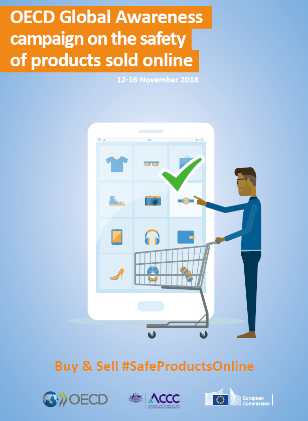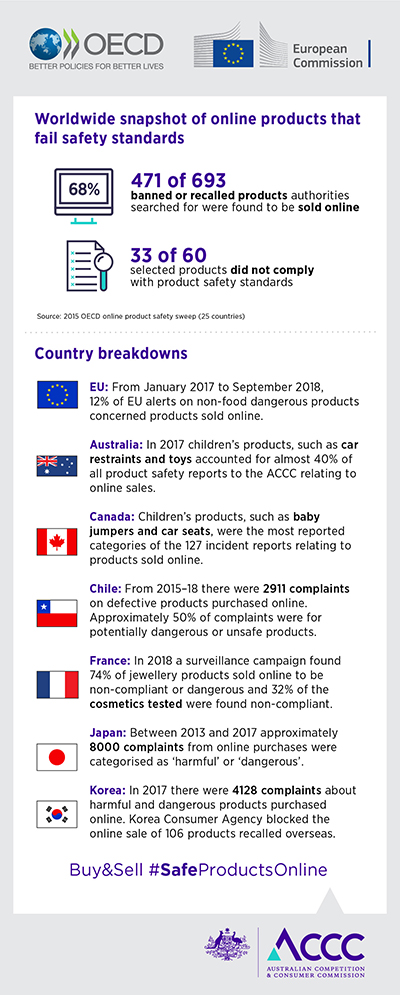Safety of products sold online
A range of non-compliant and unsafe products, which have been prohibited from sale or recalled from the market, or present inadequate product labelling and safety warnings, remain available for sale online. According to recent OECD statistics, 68% of products that were identified as banned or recalled were supplied online. In addition, 55% of 60 selected products did not comply with product safety standards.
These unsafe or defective products online can cause detriment to consumers and the broader community, including physical injury, financial burden, and even death.
From 12-16 November 2018, in conjunction with the International Product Safety Week, an OECD global awareness campaign was carried out to inform online platforms, online sellers, and consumers to raise awareness on the safety of products sold online. The campaign aimed to ensure that the products consumers buy online are safe. It also informed businesses about ways to navigate product safety regulations of various jurisdictions and to identify product safety risks.
The campaign was co-ordinated by the European Commission and Australia's Competition and Consumer Commission. The following 26 jurisdictions participated: Argentina, Australia, Brazil, Canada, Chile, Colombia, Costa Rica, Egypt, European Commission, France, Germany, Iceland, Israel, Japan, Korea, Latvia, Lithuania, Mexico, Peru, Portugal, Russian Federation, South Africa, Sweden, Turkey, United Kingdom, United States.
 Help spread the word!
Help spread the word!
- English: #SafeProductsOnline
- French: #SécuritéDesProduitsEnLigne
- Spanish: #ProductosSegurosEnLínea
- Portuguese: #ProdutoSeguroOnline
Safety messages for online sellers
Online sellers engaging in both domestic and cross-border ecommerce should:
- Sell safe products online. Understand and comply with product safety laws in any jurisdiction where you offer products.
- Share product safety information with consumers. Publish clear, accurate, easily accessible, and conspicuous product safety information and warnings about goods or services that you sell online.
- Make information accessible to consumers across borders. For cross-border transactions, make product safety information (labels, warnings, descriptions) available in appropriate languages to ensure they are easily understood by the consumers you target.
- Know which products you should not sell. Visit relevant government websites to access product safety resources in various jurisdictions and subscribe to their website alerts.
- Be responsive to consumers and authorities. Provide your contact details for consumers and authorities to enable communication in case of safety problems.
- Communicate product safety concerns. Use direct and effective communication tools to reach out to affected consumers when product safety concerns arise.
Safety messages for online platforms
Online platforms hosting sellers are urged to:
- Identify and remove unsafe products found on your platform. Conduct regular audits on your platform and explore the use of new technologies to detect and remove unsafe products. Consult domestic and international databases identifying recalled products, such as the OECD GlobalRecalls portal. Put in place measures to act against the reappearance of such unsafe products.
- Promote product safety compliance on your platform. Invite sellers to visit government websites, which describe product safety regulations, and to subscribe to their website alerts. Disseminate information to sellers about product safety regulations in markets they sell in. Make safety information easily accessible, even when it is viewed on a mobile or tablet.
- Make sellers’ contact details visible. Enhance transparency on the true identity of the seller and make his or her contact details available for consumers to manage any queries and complaints.
- Co-operate with product safety authorities. Work co-operatively with authorities in local and foreign jurisdictions to help protect consumers from unsafe products.
Safety messages for consumers
Before purchase
- Know who you're buying from. When you buy something in a shop, you know where you can return it if there is a safety problem. But when you shop online, would you know who to contact? The more information you have on the manufacturer, the importer or the seller, the better.
- Know which products you should not buy. Did you know that you can check whether the product you intend to buy has been recalled in your country or in another market? Visit local and international recall databases for unsafe products, such as the OECD's GlobalRecalls portal, the EU's Rapid Alert System for dangerous non-food products (RAPEX), or the Organisation of American States' Inter-American Rapid Alert System (SIAR).
- Read safety warnings and instructions to make the best choices. Read any safety instructions provided online. Check how to use the product safely and if there are any age restrictions or warnings. If you're unsure whether a product is suitable for your intended use, ask the seller or the website administrators for more information.
- Check ratings and reviews. Online consumer ratings and reviews can provide some indication of possible safety issues experienced by other consumers, keeping in mind that reviews might not all be authentic.
After purchase
- Consider registering your product with the manufacturer. If this option is available, you can register your product on the manufacturer's website. This way you will immediately be informed about recalls, software updates and safety information.
- Found a safety issue? Speak up! Report product safety problems to the e-retailer, third party seller and/or online platform, and contact the relevant authority in your country. Consider writing a product review to alert other potential consumers.
Video produced by Australian Competition & Consumer Commission Product Safety
Visit ACCC's #SafeProductsOnline campaign webpage
Video (in Spanish) produced by Colombia's Superintendencia de Industria y Comercio.

